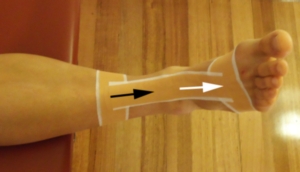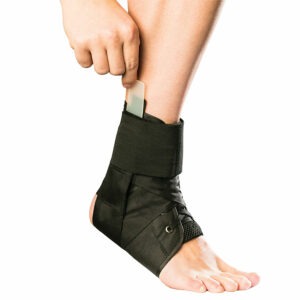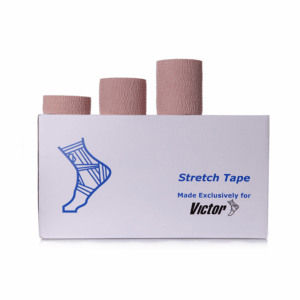Posterior Ankle Impingement Taping
Updated:
The following ankle taping techniques are designed to support and reduce stress on structures located at the back (posterior aspect) of the ankle and tendons located at the front of the ankle (such as the tibialis anterior tendon) during activity. They can be used for both the treatment and prevention of conditions such as posterior ankle impingement and tibialis anterior tendonitis.
You should discuss the suitability of these taping techniques with your physiotherapist prior to using them. Generally, they should only be applied provided they are comfortable and do not cause an increase in pain, discolouration, pins and needles, numbness or excessive redness of the foot and ankle.
What sort of tape should be used to tape my ankle?
There are many different tapes and bandages available for use by physiotherapists and patients. However, when the purpose is to restrict undesired motion, only adhesive, non-stretch (rigid) sports tape is appropriate. (For posterior ankle impingement taping 38mm is usually the most appropriate size). This should always be used in combination with hypoallergenic tape as an underlay, such as Fixomull.
Benefits of Posterior Ankle Impingement Taping
When used correctly, these taping techniques can be used to:
- Aid healing of certain injuries (such as tibialis anterior tendonitis, tibialis anterior strain, posterior ankle impingement)
- Allow an earlier return to sport or activity following injury
- Reduce the likelihood of injury aggravation during sport or activity
Indications for Posterior Ankle Impingement Taping
It is generally beneficial to apply these taping techniques in the following instances:
- Following certain injuries – Posterior ankle impingement taping may be beneficial following sudden or gradual onset injuries to the back of the ankle joint (such as posterior ankle impingement, and some patients with ankle osteoarthritis, ankle synovitis or osteochondral lesions of the talar dome) or for conditions such as tibialis anterior tendonitis or a tibialis anterior tear. These taping techniques are particularly useful during activities that aggravate or are likely to aggravate the existing condition (this should be discussed with the treating physiotherapist as certain injuries should not be taped).
- To prevent injury – Posterior ankle impingement taping may be beneficial during sports or activities that place the ankle or tibialis anterior tendon, at risk of injury (such as dancing, fast bowling in cricket, kicking sports – football, soccer and running – particularly downhill).
When should I avoid Posterior Ankle Impingement Taping?
Posterior ankle impingement taping should be avoided in the following instances:
- If you have certain injuries such as some fractures (this should be discussed with the treating physiotherapist).
- If you have a skin allergy to sports tape.
- If the taping technique results in an increase in symptoms such as pain, ache, discolouration, pins and needles, numbness or excessive redness of the foot or ankle.
- If you have circulatory problems.
Weaning off Posterior ankle impingement tape in general activity is usually recommended as strength, range of movement and balance improves and symptoms reduce. In some instances though, taping during high-risk activity (such as some sports) may still be recommended.
Posterior Ankle Impingement Taping Techniques
The following taping techniques may be used to provide support for structures located at the back of the ankle or tendons located at the front of the ankle (such as the tibialis anterior tendon), and are particularly beneficial for patients suffering from injuries such as: posterior ankle impingement or tibialis anterior tendonitis).
Generally, it is recommended that the lower leg / ankle is shaved 12 hours prior to taping (to prevent painful removal of hairs and skin irritation). The skin should be cleaned removing any grease or sweat. Low irritant Fixomull tape should be applied as an underlay to reduce the likelihood of skin irritation with rigid sports tape over the top of this.
Some or all of the following taping techniques may be applied to tape the ankle and provide the support required for the individual.
Anchors
Place a strip of tape around the lower 1/3 of the shin and another one around the forefoot, just before the toes (figure 1). This should be applied gently to prevent circulatory problems and is used as a fixation point for the other taping techniques.

Straight Lines
Keeping the foot and ankle in a neutral position (i.e. the foot and toes should be approximately perpendicular to the lower leg – see figure 1), start the tape at the level of the lower leg anchor. Begin this taping technique by following the black arrow (figure 2) and conclude this taping technique at the level of the forefoot anchor by firmly following the white arrow (figure 2). Do 1 or 2 straight lines either centrally or slightly adjacent to each other depending on the size of the ankle and the amount of support required.

Crosses

Members Only ContentBecome a PhysioAdvisor Member to gain full access to this exclusive content. For more details see Become a Member. Already a member? Login Now
Complete Posterior Ankle Impingement Taping

Members Only ContentBecome a PhysioAdvisor Member to gain full access to this exclusive content. For more details see Become a Member. Already a member? Login Now
Removing the tape
Care should be taken when removing the tape to avoid injury aggravation or skin damage. Blunt nosed tape scissors should be used. The tape should be removed slowly, pulling the tape back on itself with pressure placed on the skin as close as possible to the line of attachment of the tape.
Generally tape should be removed within 48 hours of tape application, or sooner, if there is any increase in pain or symptoms (including skin irritation or itchiness).
 Physiotherapy products for Posterior Ankle Impingement Taping
Physiotherapy products for Posterior Ankle Impingement Taping
To purchase physiotherapy products to assist with Posterior Ankle Impingement Taping click on one of the above links or visit the PhysioAdvisor Shop to view our complete range of Sports Tape & Accessories.
 Physiotherapy Exercises
Physiotherapy Exercises
- Calf Stretches
- Calf Strengthening Exercises
- Ankle Flexibility Exercises
- Ankle Strengthening Exercises
- Balance Exercises
 Find a Physio
Find a Physio
Find a physiotherapist in your local area who can help with Posterior Ankle Impingement Taping.
 Recommended Reading
Recommended Reading
- Posterior Ankle Impingement
- Tibialis Anterior Tendonitis
- Ankle Synovitis
- Osteochondral Lesions of the Talar Dome
- R.I.C.E Regime
- Ice or Heat?
- How to Use Crutches
- Warming Up and Cooling Down
- Injury Prevention
- Return to Running
- Return to Sport
- Choosing a Shoe
- Do I Need Orthotics?
- Ankle Diagnosis Guide
 Other Taping Techniques
Other Taping Techniques
- Achilles Tendon
- Ankle
- Back
- Calf
- Elbow
- Finger
- Foot
- Knee
- Patella
- Patella Tendon
- Posture
- Shoulder
- Tennis Elbow
- Thumb
- Wrist
Become a PhysioAdvisor Member

Link to this Page
If you would like to link to this article on your website, simply copy the code below and add it to your page:
<a href="https://physioadvisor.com.au/health/taping-techniques-lower-body/posterior-ankle-impingement”>Posterior Ankle Impingement Taping – PhysioAdvisor.com</a><br/>PhysioAdvisor offers detailed physiotherapy advice on Posterior Ankle Impingement Taping techniques used in the treatment of injuries such as Posterior Ankle Impingement or Tibialis Anterior Tendonitis.
Return to the top of Posterior Ankle Impingement Taping.





